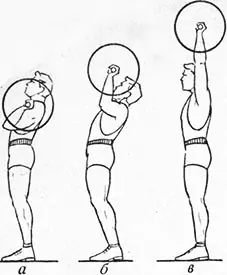The weightlifting standing press we are considering in this review is a specially auxiliary exercise that helps develop the strength of the muscles involved in pushing the barbell from the chest.
The starting position for the press and grip width are the same as for the push. The most convenient grip on the barbell is simple.
The barbell is usually lifted to the chest in a half-squat without spreading the legs, which is performed after the final phase of the pull - the so-called lift. At the same time, the barbell can also be lifted onto the chest using the “scissors” or “spread” method with a shallow squat.
After rising from a squat to a standing position, the athlete places his feet in a position that is comfortable for him (approximately shoulder-width apart, with his toes slightly turned to the sides) and takes the starting position for the press. The pelvis moves forward slightly, so that the projection of the hip joints is closer to the toes (Fig. 1, a), the lower back is secured, and the chest is raised. The elbows are slightly forward, a little further behind the line of the bar, while the head is slightly tilted back. The arms are tense only enough so that the athlete can hold the bar of the apparatus on his chest. From this position the athlete lifts (squeezes) the barbell upward.
During a weightlifting lift from the chest, the elbows are vigorously pushed upward. In this case, at first, the lifting of the barbell is carried out mainly due to the muscles that raise the shoulders. The angles at the elbow joints increase slightly. Subsequently, the athlete extends his arms at his elbow joints to a greater extent. At the same time, while extending the arms in the shoulder joints, the head tilts slightly back (this affects the tone and strength of the extensor muscles). Until the bar reaches the level of the top of your head, it is not recommended to spread your elbows wide to the sides, as this will weaken the effort aimed at lifting the bar. The forearms should maintain a slightly inclined position.
When the arms are almost completely straightened, the athlete moves the torso and head forward, and the pelvis back, and then, finally straightening the arms and straightening the torso, fixes the barbell while standing (Fig. 1, c).
Finally, we would like to draw your attention to this important point: the weightlifting version of this exercise is fundamentally different from the military press or standing press of bodybuilders in that weightlifters are focused on the most effective and explosive lifting of the projectile, and for bodybuilders the main thing is not the fact of lifting itself, but maximum concentration and accentuated work of target muscles. It is for this reason that all possible cheating options are seen in the technique of weightlifters: body swing, squatting, inertial movement and other techniques. Bodybuilders, unlike weightlifters, work with much lighter weights, but they act much slower and more concentrated in order to work and feel the muscles involved.
When working with a barbell, do not forget about the need for aerobic exercise so that your heart, respiratory and circulatory systems keep up with your muscle development. For these purposes, we recommend buying a mountain bike and moving around on it as often as possible in the summer, abandoning the car and public transport. Well, in winter, a treadmill, orbitrack, bicycle ergometer or other preferred cardio exercise machine will help you. Well, you can read in more detail about the importance of aerobic training here.
Post Views: 120


